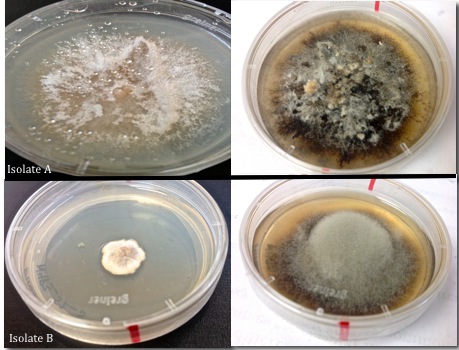
New Endophyte Database
Block title
Soils Plants and Invasion
Plants live in tight associations with microbes who colonize their roots and leaves and surrounding soil. Some microbes are harmful and cause disease while others are beneficial and aid in plant nutrient uptake, decomposition of organic materials, protection against pathogens, tolerance against drought and other stressors. Plants can influence microbial communities and vice versa with consequences for the growth of individual plants, the composition of plant communities, and entire ecosystems. In our work, we focus on three main aspects of plant-microbe interactions; 1) how they may aid or hinder plant invasions, 2) how their function changes across environmental gradients, and 3) how they may both cause and prevent disease in plants.On MPG Ranch, three highly invasive weeds of contrasting lie history strategies (cheatgrass, knapweed and leafy spurge) co-occur with remnants of native plant vegetation. Using both observational and experimental approaches, we seek to understand how these weeds alter microbial communities and how this influence invasive success, ecosystem properties and restoration. We also collaborate with researchers from across the world to learn if plant-microbe interactions differ between native and invasive ranges and how this correlates with evolutionary shifts in plant genomes and biogeographical distribution of plant associated microbes.
Outcomes of plant-soil microbe interactions depend on the particular plant and fungal species and surrounding environmental conditions. To explore this context-dependency, we use high-throughput sequencing and stable and radioactive isotopes in surveys and experiments to determine if the proportion of fungal guilds (mutualistic mycorrhizal fungi and potential pathogens) change with water and nutrient availability and how these changes relate to plant growth. Because most research occurs in single locations, the generality of findings across locations that differ in environmental conditions is often unknown. To address this, MPG Ranch is part of two global research collaborations, Nutrient Network (https://nutnet.org) and DroughtNet (www.drought-net.org). In these experiments, all researchers apply nutrients, remove herbivores, expose plants to drought, and record responses in both plant and microbial communities using the same protocols, which allow for direct comparisons across sites.
The invasive fungal pathogen, Cronartium ribicola, causes the disease commonly known as blister rust in all nine white pine species native to the United States. As one of the only labs in the world to grow C. ribicola in culture, we perform tests of pathogen metabolism when exposed to compounds produced by other fungi found in white pine needles. Greenhouse experiments inoculating trees with these fungi, as well as beneficial ectomycorrhizal fungi, explore how we can improve tree growth and disease resistance. We also use isotopes and controlled field experiments to determine how blue-stain fungi carried by bark beetles can influence wood decomposition in forest ecosystems. As warming climates increase the frequency of bark beetle outbreaks worldwide, this research will help to better estimate future forest carbon storage and release.

Recent studies show that fungi alter how plants interact in a competitive environment and potentially shape entire plant communities. Endophytes increased the competitive ability of native grasses against forbs (Vasquez-de-Aldana et al. 2013), enhanced competitive ability of plants outside their native range (Aschehoug et al. 2012), and reduced growth of nearby competitors (Shipunov et al. 2013). In May, we collected Poa secunda plants from fifteen different locations to determine if certain endophytes help P. secunda to persist in a competitive environment. We sampled from areas categorized as native, cheatgrass-invaded, knapweed-invaded or leafy spurge-invaded. We used culture-based methods to isolate the endophytic species within the plants and categorized them based on observed physical characteristics (identification by morphotype).

164 different fungal isolates grew from P. secunda tissue. Their variability in form made categorization into morphotype groups difficult. As one of the most species-rich taxonomic groups, researchers estimate that less than 7% of endophytic species have been described to date (Schmit et al. 2007). To overcome these barriers, we developed a database to organize the different morphotypes observed. With the application FilemakerGo installed on an iPad, we cataloged the physical characteristics of each fungal isolate at 10, 20 and 30 days growth to capture variation over time. Image 2 shows a screenshot of the database and the different characteristics measured.
Morphological characteristics vary between species, and a single isolate’s morphology changes as it grows. Image 3 shows isolates after one week of growth on the left and the same isolates after two weeks growth on the right. Comparisons between the same species at different times can lead to an over-estimation of the total number of morphotypes found.
1-week growth 3-week growth

We will develop similar endophyte databases for bitterbrush, cheatgrass, and other plants of interest. We can then compare these records and put each isolate into its respective morphotype group for more efficient sequencing and species identification. Once finished, this database will also help us to explore the differences in fungal community composition between sites and species.
References
1. Aschehoug ET, Metlen KL, Callaway RM, Newcombe G. 2012. Fungal endophytes directly increase the competitive effects of an invasive forb. Ecology. 93(1): 3-8.
2. Shipunov A, Raghavendra AKH, Newcombe G. 2012. Fungal endophytes in spotted knapweed influence its competitive interactions. eprint arXiv:1209.1617.
3. Schmit JP, Mueller GM. 2007. An estimate of the lower limit of global fungal diversity. Biodiversity and Conservation. 16:99-11.
4. Vasquez-de-Aldana BR. 2012. An Epichloe endophyte affects the competitive ability of Festuca rubra against other grassland species.



















